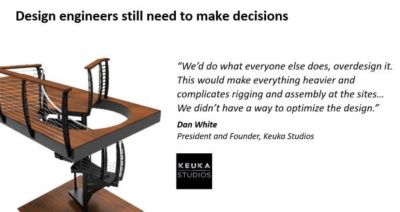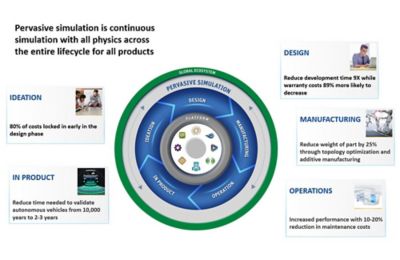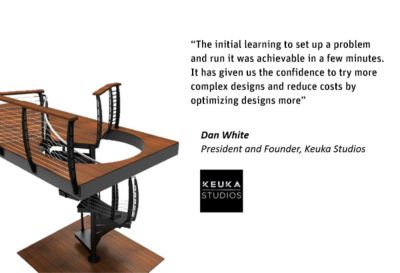-
United States -
United Kingdom -
India -
France -
Deutschland -
Italia -
日本 -
대한민국 -
中国 -
台灣
-
Ansys s'engage à préparer les étudiants d'aujourd'hui à la réussite, en leur fournissant gratuitement un logiciel de simulation.
-
Ansys s'engage à préparer les étudiants d'aujourd'hui à la réussite, en leur fournissant gratuitement un logiciel de simulation.
-
Ansys s'engage à préparer les étudiants d'aujourd'hui à la réussite, en leur fournissant gratuitement un logiciel de simulation.
-
Contactez-nous -
Carrières -
Étudiants et universitaires -
-
S'inscrire -
Déconnexion -
Espace client -
Support -
Communautés partenaires -
Contacter le service commercial
Pour les États-Unis et le Canada
+1 844.462.6797
-
ANSYS BLOG
November 13, 2018
Modern Product Development Encourages Engineers to Play with Designs
Products are becoming more complex and development cycles continue to shrink. The result of these compounding issues is that product development teams do not have time to innovate every nut and bolt in the system.
Keuko Studios’ president, Dan White, admits that overdesigning products is still a regular practice.
Almost every engineering decision could benefit from the insight of simulation. However, design innovation is stifled by the time and expertise needed to run these simulations. In fact, most engineers don’t even touch simulation software unless the word “analyst” is in their title. The result is that build and break, rule of thumb, over-engineering and baby step innovation still reign supreme.
But what if simulations took seconds to set up? What if results could be displayed nearly instantly? And what if simulation tools were intuitive enough that everyone discussing this topic at IMECE — to everyone at your local high school — could use it?
In a world where physical prototypes take months and simulations take weeks to complete, engineers are very particular about which design options they test with these tools. This culture breeds careful innovation that can slow the implementation of new ideas.
But, with Ansys Discovery Live, engineers can gain real product insights in the 10 minutes between meetings. In a new world where a mistake costs you a minute and is fixed by the undo button, you can afford to take risks and be a little inventive. If you are deliberately adventurous in digital exploration, you will change product development profoundly.
Complex Product Development Cycles Stifle Innovation
At one time, valves were purely mechanical. Today, valves are packed with electronics and numerous sensors.
These changes help make a product more useful to the consumer. However, the added complexity makes the product harder to design.
The demand to shrink development cycles and get products to market faster only compounds this problem.
Companies need to base more business decisions on simulation. Engineers need tools to optimize more parts in less time.
Simulation can help make sense of the added complexity in our products. In fact, industry’s top performers already use simulation to reduce warranty costs and development time, and to increase product roll-outs.
However, these simulations take time and the experts needed to run these simulations are far and few between. As a result, many companies only use it to answer their toughest questions. In other words, only the most complex parts in a product are simulated.
This means that too many product decisions are made without the added insights of simulation. In fact, some companies only use simulation to verify designs after most product choices have been determined explicitly or implicitly.
There is a price in limiting simulation to the development and verification stage of a product’s lifecycle. By this time, up to 80 percent of the costs are already locked in. However, if simulation were brought in during the concept and design phase then engineers could explore design options more freely and with less costly consequences. In fact, research from the International Council on Systems Engineering (INCOSE) shows that it is 20 to 100 times more expensive to address a defect later in the development phase.
Fast and Simple Simulation Breeds Adventurous Innovation
Simulation needs to be so simple that you can test your eureka moment quicker than you can draw it on the back of a napkin. Also, the software must be open enough that it can fit into any industry process.
Pervasive simulation inspires adventurous innovation throughout the development cycle.
Think of it like Excel: You don’t make a procedure to use a spreadsheet. Excel spreadsheets are made to follow your established procedures. At any time, you can start up that spreadsheet and gain insightful information in minutes. Additionally, you don’t need years of training to become competent in Excel.
Electronic spreadsheets were once the domain of mainframes owned only by the largest of organizations. They have now become commonplace. Every financial decision — whether it is made by a multinational company or a family in the suburbs — benefits from the use of an Excel spreadsheet. What once was a guarded and scarce commodity is now being used on-demand for both the complex and the mundane.
When simulation becomes this fast and easy, engineers can see how every design decision affects the overall product within minutes. This not only helps them verify these decisions. It encourages a culture where it’s okay to make mistakes and test eccentric ideas.
You can play with your design and have a little fun. Mistakes are rectified instantly with the undo button. This kind of adventurous innovation can lead to the proverbial petri dish that led to the accidental discovery of penicillin.
Ansys Discovery Live Will Innovate the Way People Design
Historically, technology becomes pervasive when it reaches a certain ease of use — think spreadsheets, smart phones or even books.
That needs to be the aim of simulation technology.
To that end, Ansys offers Discovery Live. The tool provides near instant simulation results as you interactively change your design.
This empowers engineers to play with the design. It is during this play that new innovations will be tested.
Keuka found that ANSYS Discovery Live empowered his team to test new ideas and reduce the cost of the company’s designs.
It goes without saying that traditional simulation methods won’t go away. They are still the best tools to verify critical parameters and validate the design’s performance with the highest level of accuracy.
However, when simulation is used by designers in the early stages of a product’s lifecycle, it allows traditional analysts to focus on more in-depth simulations. A design team no longer needs to overload analysts with non-critical tasks. The design team can perform simulations themselves.
In essence, Discovery Live allows everyone to design and simulate smarter.
So, allow yourself to be adventurous. Play with your design and do crazy things. The technology to test these ideas is fast and inexpensive. Like spreadsheets on a smart phone, pervasive simulation technology will change behavior. Those who embrace it first will reap the benefits.
To learn more about Discovery Live, read Every Engineer Deserves the Power of Discovery or watch my presentation at IMECE: Innovation in Engineering.














